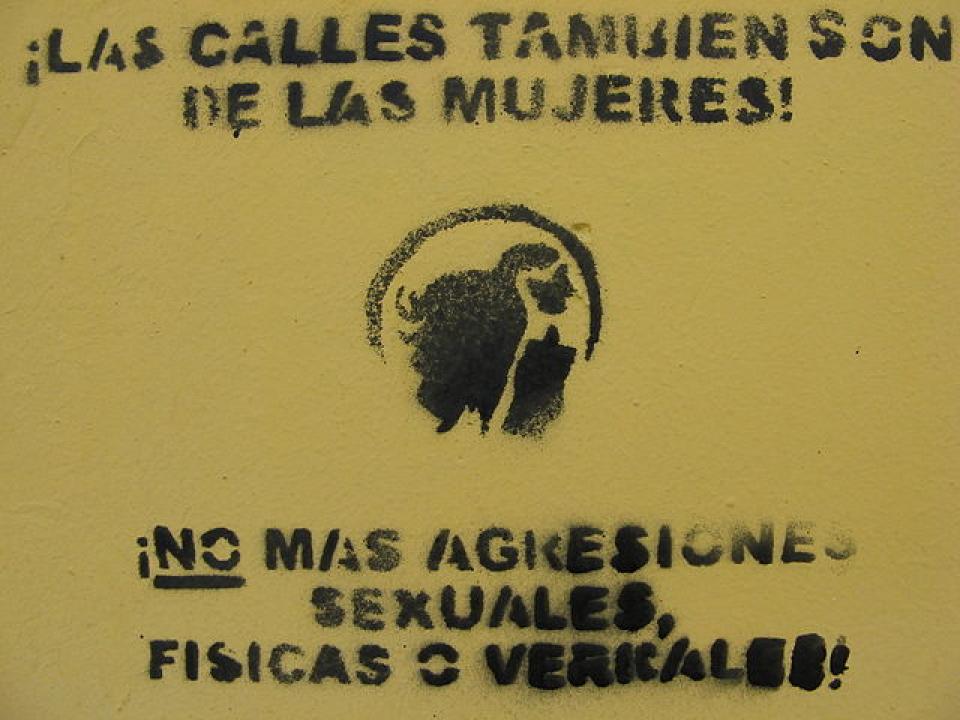
Mexico was one of the second of 7 countries covered under APC’s research project End Violence: Women’s rights and safety online. The research report from Mexico, which you can find here, uses 4 in-depth case studies to assess legal instruments, corporate policies, and women’s access to justice.
Here, GenderIT.org writer Florencia Goldsman speaks to Gabriela Polanco, the author of the report, and Erika Smith, APC’s project coordinator in Mexico, to bring us a closer look into the research findings.
Florencia Goldsman: Did technology actually enable the violence women experienced, or was it just a reflection of offline realities?
Gabriela Polanco: Violence against women (VAW) is a fact of life. Information and communication technologies (ICTs) open up another area for this violence. We do not know if the cases of violence we explored would have occurred in other ways if technology had not been present, but we do know that technology saved the perpetrators a lot of time and afforded them anonymity and omnipresence. ICT-related VAW will continue to exist wherever women have access to technology, because it is not a specific form of violence, but rather an extension of the culturally accepted violence done to women.
ICT-related VAW will continue to exist wherever women have access to technology, because it is not a specific form of violence, but rather an extension of the culturally accepted violence done to women.
Erika Smith: What is clear is that the forms of violence carried out through technology are part of a larger continuum of violence, and can often extend or exacerbate abuse. The role of technology in each of the case studies was different. In Mary’s case, the use of mobile phones allowed her aggressor to manipulate and control her mobility even at a distance, eventually allowing him to kidnap and rape her. In Morgana’s case, a Facebook gossip page attempted to shame her, which had an immediate and widespread impact in her small community and affected her daily life. The altered video of Berenice, showing her face on another woman’s naked body, can still re-emerge at any time and again put her professionally and even physically at risk. In the case of Louisa, a lesbian activist, it was the bits of personal data that she had shared online over the years that meant her anonymous abusers could pinpoint where she lived.
FG: There are large divides in terms of access to technology education: between men and women, but also between women of different socio-economic backgrounds, geographical locations, etc. Does this affect how violence is experienced?
GP: What the cases show is that violence against women on the internet respects no boundaries – not even educational levels. Women who hold doctorates have been targeted, as well as women and girls who never finished high school. In general, women are behind the curve in using technologies. Not only do we need to bridge that gap and make technology accessible to future generations of girls, but also teach them how to use it safely and responsibly.
FG: The report finds that because ICTs let aggressors remain anonymous, this can give them greater power over their targets. How important was anonymity in the cases studied ?
GP: There are two sides to the coin. On the one hand, anonymity is an important factor, with technology working in favour of the aggressors. In Mary’s case, although the perpetrator was not an unknown person but a close relative, technology allowed him to hide his interactions with her. When they met he was quite indifferent to her presence, but at the same time, he was harassing her via text message. On the other hand, anonymity protects your identity – for example, as a human rights defender – by separating your public and private spaces. To address this duality, Berenice recommended that we need more ICT education, so that women cannot be hacked and can use anonymity in their favour in a safe environment.
FG: The report shows that in the absence of national ICT laws, internet intermediaries are mostly self-regulated. What are the implications of this?
GP: Self-regulation means that technology intermediaries are free to set their own standards. They decide what can and cannot be posted online based entirely on their own criteria. There are no national or commercial standards for customer service, so everything depends on the companies. Guidelines are very general and seem to be applied at their own convenience.
Self-regulation means that technology intermediaries are free to set their own standards. They decide what can and cannot be posted online based entirely on their own criteria.
ES: The report discusses international intermediaries like Facebook, Twitter and Google, but also covers smaller scale intermediaries, such as one user-driven porn site. Berenice got a more positive response on issues of consent from the porn site than other women have received from big social networks like Facebook. A problem for women was that each company decides what gets to stay online, and this decision is often in contradiction to their own Terms of Service.
FG: The report states that although women found ways to stop the violence, they did not necessarily obtain justice. What is the difference between ending violence and getting justice?
GP: Justice is a very broad concept. The women put a stop to the violence because they looked for solutions. Whether or not they obtained justice depends on what justice meant to them and how they began to live out their rights and freedoms. For example, a woman might say, “I will not leave Facebook; however I will use it in a safe way.” This is a form of justice, too.
“I will not leave Facebook; however I will use it in a safe way.” This is a form of justice, too.
ES: There is an on-going debate about our understanding of the meaning of justice. Perhaps we can also talk about transformative justice that does not necessarily emerge from a legal framework. We found that unsatisfactory responses from the justice system are also mirrored by internet intermediaries. Survivors no longer bother to return to the police, nor do they use platforms’ complaints mechanisms, especially if their first report was dismissed. In cases of extreme stalking, the advice is “get off Facebook” or “leave the environment where you are at risk,” but we’re talking about people’s lives! What role should the police play in protecting me? That I should get out of my own life?
FG: Why is technology-related violence so lightly dismissed?
GP: Basically this is because there are no federal laws specifically covering tech-related violence against women (VAW) in Mexico, and therefore no equivalent state laws, let alone enforcement protocols. There are no laws that link ICTs with violence, so when this sort of situation comes up, the official response is that it is not covered by either the criminal or civil code, and the authorities can do nothing for you. This makes situations of technology-related VAW invisible.
FG: In every case, the women experienced psychological harm. Is this related to why authorities don’t take these issues seriously?
GP: Mexican society tends to minimise psychological violence. This is reflected in the criminal code, where physical violence is punished by a prison term or a fine, but psychological violence is not liable to similar sentences. So cases like Morgana’s, where emotional harm is the biggest effect, are not taken seriously. The trouble with psychological harm is that it is intangible, so how do you prove it? It is invisible in terms of proof. In practice, it is an example of an area where unfortunately the criminal code does not work. Think about bruising, where the police often say, “If you have no bruises to show…come back when you do.”
FG: Do you think the research impacted the women survivors themselves?
GP: I think it raised their awareness somewhat, and gave them a chance to reflect on their own cases. Telling their story allowed them to think it through and take a fresh look at it from a different perspective.
ES: When Berenice contacted us she was under a lot of stress, but over time she reached the point where she could say, “This is not who I am, and I am not going to carry on living in a closed space.” The study helped them to come out of those spaces. Now we need to go back and find out how they feel their cases have turned out, and what further recommendations they may have.
FG: What are the next steps for the Mexico study?
ES: Gabriela succeeded in getting technology-related VAW on the table when her inputs were incorporated into recommendations for amending the Law on Women’s Access to a Life Free from Violence in 2014 as part of a working group with the federal legislature’s Equality Commission.
Gabriela succeeded in getting technology-related VAW on the table when her inputs were incorporated into recommendations for amending the Law on Women’s Access to a Life Free from Violence in 2014 as part of a working group with the federal legislature’s Equality Commission.
GP: There was already concern about VAW and ICTs, but there was no basis for talking about them. Equality Commission representatives were willing to do so, but did not understand a lot about technology. My experience in this project and the inputs that APC contributed via Erika fed into the debates, and this allowed our studies to be included in the proposals to amend the law. * (see footnote)
FG: How do you foresee the legislative changes around technology-related VAW being implemented?
GP: It is a slow process, because first the federal laws and the laws in Mexico’s 32 states need to be brought into alignment with each other, which will not happen until after 2016. First the criminal codes in all states must be made equivalent to the federal law on Women’s Access to a Life Free of Violence, and a protocol must be designed for authorities to enforce the laws. This requires a paradigm shift amongst the people in charge of receiving complaints, who tend to minimise all forms of violence against women.
ES: It was depressing, during the research study, to see how little justice had been achieved. But then you begin to see that there are positive steps forward, such as how women’s experiences fed into proposals to reform the law, or in Chihuahua, where there is a bill on sexting that focuses on violations of consent rather than moral censorship. When we see feminists realising that they are being attacked online and when we see internet rights specialists realising they have to take online violence against women seriously – then I feel hopeful.
Image: A poster in S. Cristobal de Las Casas, Chiapas, Mexico (Translation: The streets, also, are for women! No more sexual-abuse, physical or verbal violence.) via Wikipedia Commons licensed under the Creative Commons Attribution-Share Alike 2.0 Generic license
*The Equality Commission working group’s recommendations emphasised threats, harassment, and the non-consensual dissemination of information. Unfortunately, a sweeping definition of “cyber violence” was adopted into law in Spring 2015. This new definition is so broad it can potentially be used to censor a range of speech and expression. http://gaceta.diputados.gob.mx/Gaceta/62/2014/dic/20141209-VII.html#Inic...
- 11053 views






Add new comment